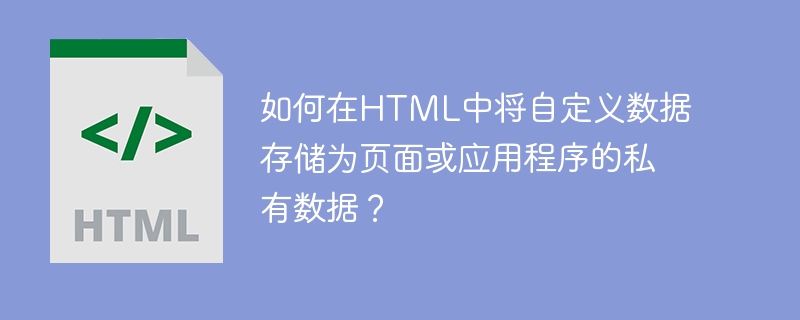 Web Front-end
Web Front-end
 HTML Tutorial
HTML Tutorial
 How to store custom data in HTML as private data for the page or application?
How to store custom data in HTML as private data for the page or application?
How to store custom data in HTML as private data for the page or application?

Custom attributes are specially designed attributes that are not included in the standard HTML5 attributes. They allow us to customize HTML tags by adding our own data.
A custom attribute is any attribute that starts with data-. We can embed custom attributes on all HTML components using data-* attributes.
Syntax: HTML
In HTML, the syntax of data-* attributes is relatively simple. Every element starting with data- is a data-* attribute.
<sample_data> id = “sample” data-index = 1 data-row = 23 data-column = 44 </sample_data>
Syntax: Use JavaScript to access
Accessing these data properties using JavaScript is also relatively simple. We can use getAttribute() with its full HTML name, which can be read using the dataset attribute.
const article = document.querySelector('#sample');
sample_data.dataset.index;
sample_data.dataset.row;
sample_data.dataset.column;
Syntax: Access using CSS
Use the CSS attr() function to access data.
sample_data::before {
content: attr(data-index);
}
The following are examples...
The Chinese translation ofExample
is:Example
In the following example, we use JavaScript to read the value of the attribute.
<!DOCTYPE html>
<html>
<body>
<h1 id="Result">Result</h1>
<ul>
<li onclick="showPosition(this)"
id="Siddarth" data-position="winner">
Siddarth
</li>
<li onclick="showPosition(this)"
id="Arjun" data-position="runner up">
Arjun
</li>
<li onclick="showPosition(this)"
id="Badri" data-position="third">
Badri
</li>
<li onclick="showPosition(this)"
id="Nanda" data-position="lost">
Nanda
</li>
</ul>
<script>
function showPosition(runner) {
var position = runner.getAttribute("data-position");
alert("The " + runner.innerHTML + " is " + position + ".");
}
</script>
</body>
</html>
Output
When the above script is executed, it will generate an output of a list of names containing some data.
When you try to click on any of the names, the function gets the data and displays an alert box showing the custom data we used.
The above is the detailed content of How to store custom data in HTML as private data for the page or application?. For more information, please follow other related articles on the PHP Chinese website!

Hot AI Tools

Undresser.AI Undress
AI-powered app for creating realistic nude photos

AI Clothes Remover
Online AI tool for removing clothes from photos.

Undress AI Tool
Undress images for free

Clothoff.io
AI clothes remover

Video Face Swap
Swap faces in any video effortlessly with our completely free AI face swap tool!

Hot Article

Hot Tools

Notepad++7.3.1
Easy-to-use and free code editor

SublimeText3 Chinese version
Chinese version, very easy to use

Zend Studio 13.0.1
Powerful PHP integrated development environment

Dreamweaver CS6
Visual web development tools

SublimeText3 Mac version
God-level code editing software (SublimeText3)

Hot Topics
 Is HTML easy to learn for beginners?
Apr 07, 2025 am 12:11 AM
Is HTML easy to learn for beginners?
Apr 07, 2025 am 12:11 AM
HTML is suitable for beginners because it is simple and easy to learn and can quickly see results. 1) The learning curve of HTML is smooth and easy to get started. 2) Just master the basic tags to start creating web pages. 3) High flexibility and can be used in combination with CSS and JavaScript. 4) Rich learning resources and modern tools support the learning process.
 The Roles of HTML, CSS, and JavaScript: Core Responsibilities
Apr 08, 2025 pm 07:05 PM
The Roles of HTML, CSS, and JavaScript: Core Responsibilities
Apr 08, 2025 pm 07:05 PM
HTML defines the web structure, CSS is responsible for style and layout, and JavaScript gives dynamic interaction. The three perform their duties in web development and jointly build a colorful website.
 Understanding HTML, CSS, and JavaScript: A Beginner's Guide
Apr 12, 2025 am 12:02 AM
Understanding HTML, CSS, and JavaScript: A Beginner's Guide
Apr 12, 2025 am 12:02 AM
WebdevelopmentreliesonHTML,CSS,andJavaScript:1)HTMLstructurescontent,2)CSSstylesit,and3)JavaScriptaddsinteractivity,formingthebasisofmodernwebexperiences.
 Gitee Pages static website deployment failed: How to troubleshoot and resolve single file 404 errors?
Apr 04, 2025 pm 11:54 PM
Gitee Pages static website deployment failed: How to troubleshoot and resolve single file 404 errors?
Apr 04, 2025 pm 11:54 PM
GiteePages static website deployment failed: 404 error troubleshooting and resolution when using Gitee...
 What is an example of a starting tag in HTML?
Apr 06, 2025 am 12:04 AM
What is an example of a starting tag in HTML?
Apr 06, 2025 am 12:04 AM
AnexampleofastartingtaginHTMLis,whichbeginsaparagraph.StartingtagsareessentialinHTMLastheyinitiateelements,definetheirtypes,andarecrucialforstructuringwebpagesandconstructingtheDOM.
 How to use CSS3 and JavaScript to achieve the effect of scattering and enlarging the surrounding pictures after clicking?
Apr 05, 2025 am 06:15 AM
How to use CSS3 and JavaScript to achieve the effect of scattering and enlarging the surrounding pictures after clicking?
Apr 05, 2025 am 06:15 AM
To achieve the effect of scattering and enlarging the surrounding images after clicking on the image, many web designs need to achieve an interactive effect: click on a certain image to make the surrounding...
 HTML, CSS, and JavaScript: Essential Tools for Web Developers
Apr 09, 2025 am 12:12 AM
HTML, CSS, and JavaScript: Essential Tools for Web Developers
Apr 09, 2025 am 12:12 AM
HTML, CSS and JavaScript are the three pillars of web development. 1. HTML defines the web page structure and uses tags such as, etc. 2. CSS controls the web page style, using selectors and attributes such as color, font-size, etc. 3. JavaScript realizes dynamic effects and interaction, through event monitoring and DOM operations.
 How to implement adaptive layout of Y-axis position in web annotation?
Apr 04, 2025 pm 11:30 PM
How to implement adaptive layout of Y-axis position in web annotation?
Apr 04, 2025 pm 11:30 PM
The Y-axis position adaptive algorithm for web annotation function This article will explore how to implement annotation functions similar to Word documents, especially how to deal with the interval between annotations...





